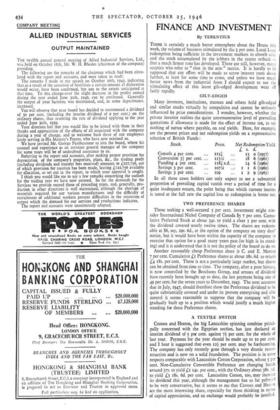FINANCE AND INVESTMENT
By TERENTIUS
THERE is certainly a much better atmosphere about the House this week, the volume of business stimulated by the 3 per cent. Local Loan redemption being sufficient in the investment markets to absorb sales and the stock accumulated by the jobbers in the recent setback so that a much firmer tone has developed. There are still, however, many sceptics who refer to " shot in the arm " tactics. It is hardly to be supposed that any effort will be made to screw interest rates down further, at least for some time to come, and unless we have much better news from the industrial front I should expect to see the stimulating effect of this latest gilt-edged development wear off fairly rapidly.
GILT-EDGED
Many investors,, institutions, trustees and others hold gilt-edged and similar stocks virtually by compulsion and cannot be seriously influenced by price considerations. I wonder, however, whether the private investor realises the quite unremunerative level of prevailing quotations if allowance is made for the effect of income tax, to say nothing of surtax where payable, on real yields. Here, for example, are the present prices and net redemption yields on a representative selection of British Funds*: Stock. Price. Net Redemption Yield.
£ s. d.
13 0 (1957) 18 6 (1961) 14 6 (1960)
6 (1960) I 2 9 (1965) In all these cases holders can only expect to see a substantial proportion of prevailing capital vanish over a period of time for a quite inadequate return, the point being that which current income is taxed at the full rate the capital loss to redemption is borne net.
TWO PREFERENCE SHARES
Those seeking a well-secured 5 per cent. investment might con- sider International Nickel Company of Canada $5 7 per cent. Cumu- lative -Preferred Stock at about 34s. to yield a clear 5 per cent. with the dividend covered nearly twelve times. The shares are redeem- able at $6, say, 29s. 6d., at the option of the company on sixty days' notice, but it would have been within the capacity of the company ro exercise that option for a good many years past .(so high is its stand- ing) and it is understood that it is not the policy of the board to do so.
Another reasonably cheap Preference share is C. and E. Morton 7 per cent. Cumulative LI Preference shares at about 28s. 6d. to return £4 18s. per cent. There is not a particularly large market, but shares can be obtained from time to time. The company, after a poor history, is now controlled by the Beechams Group, and arrears of dividend have recently been brought up to date, the last payment being one of 49 per cent. for the seven years to December, 1945. The next accounts due in July, 1947, should therefore show the Preference dividend to be quite substantially covered and under its present enterpising and able control it seems reasonable to suppose that the company will be gradually built up to a position which would justify a much higher standing for these Preference shares.
A TEXTILE SWITCH Crosses and Heaton, the big Lancashire spinning combine princi- pally concerned with the Egyptian section, has just declared an interim dividend of 5 per cent. against 71 per cent. for the whole of last year. Payment for the year should be made up to io per cent. and I hear it suggested that even 121- per cent. may be forthcoming. The company has only recently gone through a very drastic recon- struction and is now on a solid foundation. The position is in some respects comparable with Lancashire Cotton Corporation, whose 5 Per cent. Non-Cumulative Convertible Preference are changing hands around 37s. to yield £2 14s. per cent., with the Ordinary about 38s. 3d. to yield £3 18s. 6d. per cent. Lancashire Cotton, too, may increase its dividend this year, although the management has so far peferled to be very conservative, but it seems to me that Crosses and Heaton are the more interesting share, especially for those thinking in terms of capital appreciation, and an exchange would probably be justified.
Consols 4 per cent. Conversion 31 per cent. Funding 4 per cent. Savings 3 per cent. Savings 3 per cent. II5i
113-4 ... 1188 x.d.... to7H-
109






























 Previous page
Previous page